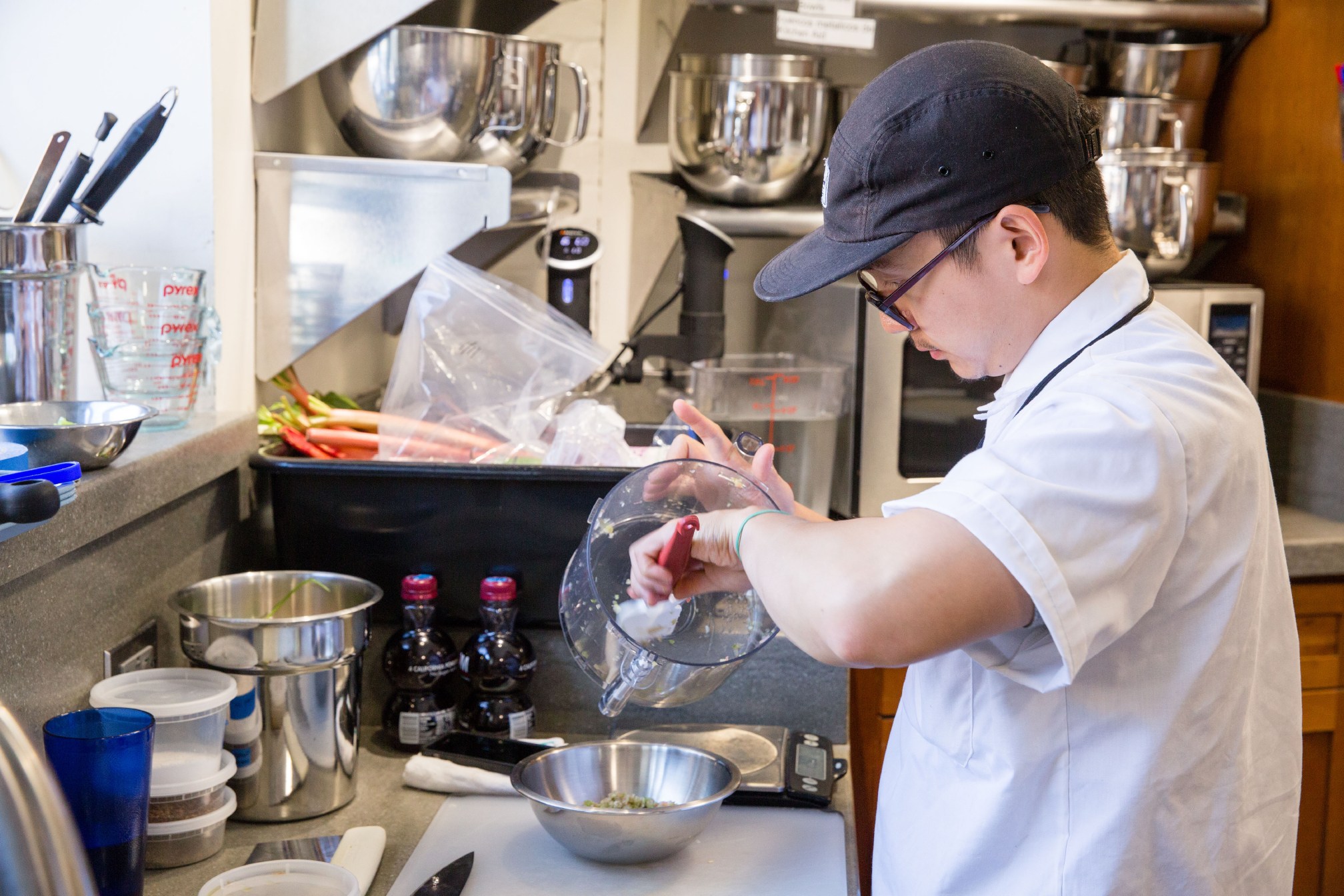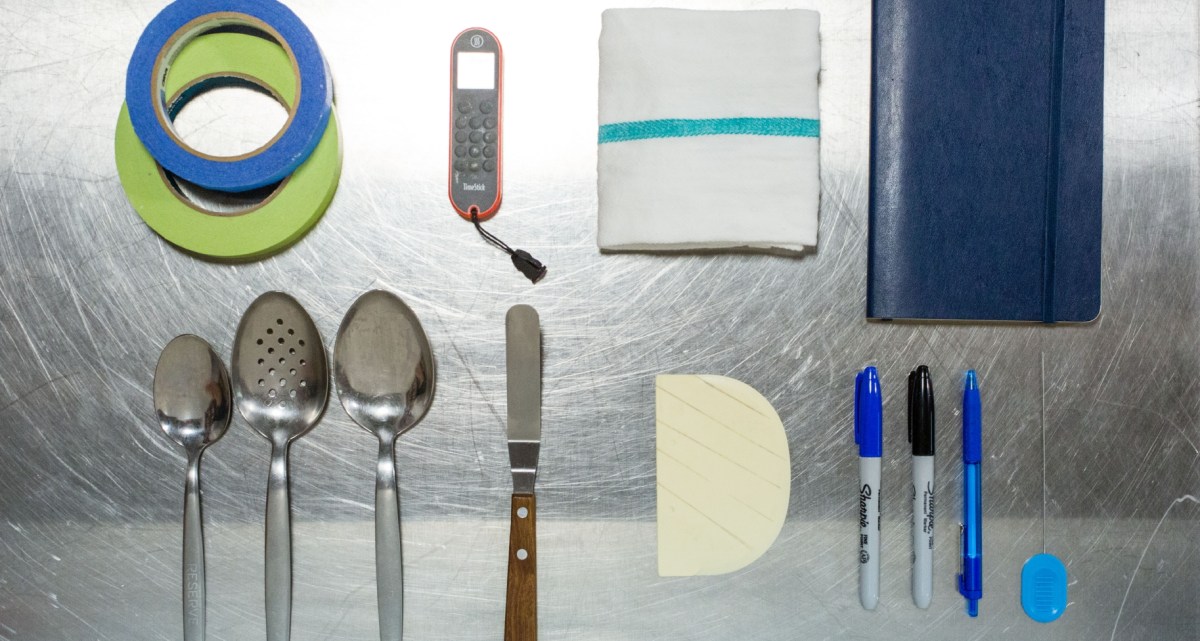In this weekly series, associate editor Tim Chin and test cook Sasha Marx take you behind the scenes of Cook’s Science and give you a glimpse into our recipe development process, from how we come up with recipe ideas, to test kitchen failures, to discoveries we make along the way. This week, Tim tells us about a few of his favorite kitchen tools.
A couple months ago, Sasha shared some of his insights into staying organized and working “clean” in the kitchen. If you didn’t catch the hint the first time around, to cook is to control chaos. And in this constant battle against entropy, organization and cleanliness are integral to being a good cook—whether at home or on the line. Sasha did an excellent job of outlining his general approach in the kitchen. But this week I thought I’d elaborate on more of the nitty-gritty. A lot of you probably have a good idea of what basic equipment you need in your kitchen: a sharp knife, a cutting board, maybe some good pots and pans. But beyond that, there are certain items that can take your cooking to the next level. So without further ado, and in no particular order, here’s a list of things that help keep me working lean, mean, and clean in the test kitchen:
Towel
A towel is the great equalizer. I wouldn’t survive a day in the kitchen without one. In The Hitchhiker’s Guide to the Galaxy, a towel is even listed as the single most important item an interstellar hitchhiker can carry. Beyond cleaning up general spills, messes, and wiping all the flour off your face, towels are perfect for handling hot pans, pots, and roasting racks. And in a pinch, you can even use a towel to hold a bowl steady, as a makeshift bandana, or even as a facemask when the fumes are getting too intense. So get yourself a towel, neatly fold it, and keep it next to you as you work, tucked in your back pocket, or hitched to your apron. Better yet, get two or three.

Tape
Professional cooks have an unhealthy obsession with labeling. In one kitchen I worked at, we had to label, date, and initial everything we made, from stocks to sauces to ice creams to perfectly portioned slices of hamachi. The tape edges had to be squared off and always affixed one inch from the top of the container. If anything went wrong with a dish, my chef would know exactly who to set his sights on based on the label. Here at the test kitchen, the stakes aren’t quite so high (or scary). But we still label and date everything so we can keep track of our projects. And you’ll find that it’s a useful way to keep track of leftovers and ingredients at home. I recommend masking tape, or even better, blue or green painter’s tape since it peels right off without leaving any residue.
Permanent Markers and Pens
What else are you gonna use to write on your tape?
Notebook
Like Sasha said, a notebook is an old school method of note taking. But it sure beats getting chicken fat all over your laptop. And when I’m just sketching out ideas, a notebook allows for a little more freedom. Sasha and I both have stacks and stacks of small notebooks from our time in kitchens. They’re chock full of recipes, sketches, and general chicken scratch. These notebooks serve as record of accumulated knowledge and help inspire our recipe development. For any home cook who hopes to develop their own recipes, copy down recipes, or otherwise track progress, a notebook is essential.
Spoon Bain
Originally designed for slow cooking of delicate foods in a bain-marie system, these are cylindrical, stainless steel containers that come in a range of sizes. They can hold spoons, spatulas, and all of your small tools in one place without taking up too much space on your counter. Keeping one right next to your stove allows for easy access.

Kitchen Scissors
A good pair of small kitchen scissors can be indispensible—especially when you don’t have a knife handy. They are good for jobs both big and small. You can make quick work of delicate herbs by snipping them to exact size with no fear of bruising them. Or you can break down tough lobsters and crabs in a flash. They even work for small poultry like quail and guinea hen. Cut cheesecloth, parchment circles, cardboard, you name it. Plus, it’s the best way to cut all the tape that Sasha and I go through. You can’t go wrong with a pair of Joyce Chen scissors. Sasha also swears by the sleeker Mac brand.
Spoons
An extension of the hand. Stir, scrape, flip, baste, sauce, spread—spoons can do it all. Use them for tasting, use them for plating, use them when you’re not really sure which tool to use, but when you still gotta use something. Find spoons of all sizes and shapes: flat, deep, wide, perforated, big, and small. Restaurant cooks swear by the oversized, well-balanced spoons designed by chef Gray Kunz for use in the kitchen, but I’ve found some of the best spoons at thrift stores and antique shops.
Teeny Tiny Itty Bitty Rubber Spatula
A mini rubber spatula comes in handy for stirring small pots, scraping the last bits of cream out of a bowl, or getting sticky stuff out of jars. Its thin profile and lightness make it an easy inclusion in any cook’s toolkit.
Small Metal Offset Spatula
If a spoon is an extension of the hand, then the small metal offset spatula might be an extension of the finger. While it’s great for more detail-oriented work like spreading a fine layer of frosting on a cake, it’s also good for more unconventional uses like scooping out small amounts of salt, flipping steaks, and picking up really small, delicate garnishes or cookies. In case you were wondering, it also doubles as a solid alternative to a flathead screwdriver: I’ve used it countless times to repair Kitchenaids and refrigerator doors. I’ve even heard of cooks sharpening one side of the spatula for use as a makeshift paring knife (though I don’t recommend this).
Bowl Scraper/Bench Scraper
Sometimes you don’t want to dirty a towel or use your knife when you’re cleaning off your cutting board. A plastic or metal scraper does a fine job of corralling all those bits of mirepoix into a bowl, and makes cleaning up a breeze. Use it to scrape scraps from your cutting board directly into the trash, or for transferring prepped ingredients into a bowl or pot. Plus, it’s oh-so satisfying when you can get everything off the table in a couple clean swipes.
Timer
How will you know when to pull those buns out of the oven? A small timestick or digital tabletop timer will take you a long way, especially if you’ve got multiple pans in the fire at once.
Cake Tester
I can count the number of times I’ve actually used a cake tester for testing cakes—though make no mistake, they’re great for that. I’m seldom without one in the pocket of my chef’s coat. Yes, they’re useful for checking whether cakes or brownies are done, but they can do so much more. You can use one to test the doneness of many other foods in a relatively non-invasive way. You can get a quick-and-dirty temperature reading on a steak (by inserting, removing, and comparing the temperature of the metal to your finger or lower lip), and easily test the doneness of potatoes or carrots. The ones I use are super inexpensive.
And there you have it. Those are some things that help me stay organized and sharp in the kitchen. This list is by no means exhaustive, but it’s a great starter toolkit for those who want to take their kitchen OCD to the next level.
What are your must-haves in the kitchen? Have you come up with alternative uses for kitchen tools? Tell us about it in the comments.
And in the immortal words of Towlie, don’t forget to bring a towel.
Photography by Steve Klise



